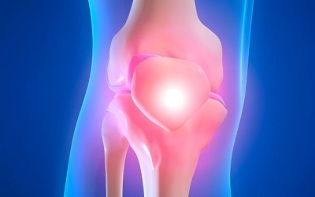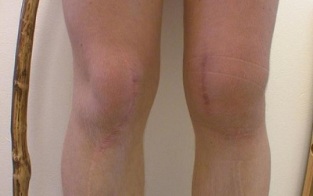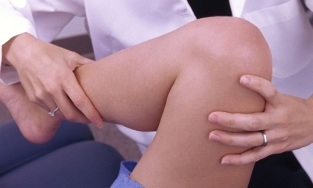
In the group of diseases of the musculoskeletal system of degenerative-dystrophic origin, knee osteoarthritis of the knee takes first place.
Gonarthrosis, or osteoarthritis of the knee joint, is a disease that is accompanied by the slow destruction of the cartilage tissue of the joint, involving the entire joint in the pathological process, including the ligaments, synovia, subchondral bone and other elements of the joint.
Under the influence of various factors such as infectious diseases (colds, flu, typhoid, tuberculosis, syphilis, tonsillitis and others), injuries, dysfunction of the joint (for example, in athletes, hardworking workers, ballet dancers) there is a violation of trophism(Nutrition) of the cartilage tissue of the knee joint, as a result of which the cartilage becomes thinner and destroyed, sometimes to the point of complete disappearance.
Who is at risk? First, with osteoarthritis of the knee joint, there is a risk that women over forty years of age are "earned". You have them twice as often as in the strong half of humanity. In addition, the risk increases in women who tend to be overweight or obese.
But by and large, osteoarthritis of the knee is a disease of the elderly. And there is a simple explanation for that. As you know, about 70-80% water in cartilage tissue makes it absorbent well. In addition, at a young age, chondrocytes "restore" cells actively work. With age, the amount of moisture decreases, and therefore the ability to cushion the joint deteriorates, the cartilage becomes dry, fragile and cracked, and the chondrocytes present do not have time to repair damage. This explains the occurrence of osteoarthritis of the knee joint in many ways.
Causes of the disease

Predisposing factors are obesity, physical inactivity, chronic joint injuries or systematic joint microtrauma, alcohol abuse, chronic stress, previous or existing knee joint diseases such as:
- knee arthritis,
- Sprain, partial or complete ligament tear,
- intra-articular fracture of the femur or tibia,
- Metabolic disorders such as gout and a number of other pathological conditions.
Very often it is not possible to determine a specific cause for knee osteoarthritis of the knee. In this case, it is a combined cause, that is, osteoarthritis of the knee was the result of several diseases at the same time.
Also, for the sake of occurrence, the disease is usually divided into two forms: primary and secondary.
Primary osteoarthritis is caused by age and the factors associated with it, e. g. B. :
- Professional disposition,
- Overweight,
- obesity,
- Varicose veins of the lower extremities.
The cause of a secondary osteoarthritis of the knee can be a previous knee injury (fracture, rupture of the ligamentous apparatus), which is known as post-traumatic osteoarthritis of the knee joint. The same reason can be a previous infectious disease or inflammation of the knee joint.
Symptoms
Signs of osteoarthritis of the knee joint do not appear overnight, the development of the disease is gradual and often lasts for several months or even years. Pain that is permanent and increases with physical activity - walking, running, descending or climbing stairs, etc. - comes to the fore. Another symptom that is characteristic of this disease is the presence of crepitus in the joint. It may be a crackle or crunch in the knee.
Also very common manifestations of gonarthrosis are:
- an increase in the local temperature (the connection feels hot) or in general
- Presence of joint swelling,
- increases the volume,
- difficulty moving,
- Deformity of the joint followed by a curvature of the limb.

As the disease progresses, the body has no choice but to defend itself when the cartilage tissue is completely destroyed. This manifests itself in the proliferation of bone tissue on the bones, which form the joint in the form of "thorns" (osteophytes), resulting in deforming osteoarthritis of the knee joint. Exudate occurs in the joint cavities.
Depending on the size of the osteophytes and the degree of deformation, different degrees of gonarthrosis are distinguished:
- Gonarthrosis grade 1. The patients feel stiffness and slight pain in the joint in the morning or when sitting or standing for long periods. At this point there is no deformity of the joint and mobility is fully preserved. An x-ray shows a small osteophyte.
- Grade 2 gonarthrosis.Painful sensations occur not only in the morning, but even after prolonged exertion, the joint is deformed, the articular surfaces are enlarged, which also increases the volume of the joint, it is difficult to flex, and a crunch can be felt when moving. X-ray shows pronounced osteophytes, the joint space is not changed.
- 3rd degree gonarthrosis.The manifestations are the same as in the second degree, only the symptoms become stronger. The pain is permanent, it does not subside even in rest and sleep. The function of the joint is almost completely lost, patients can neither bend nor straighten the leg. As a result, lameness occurs, movement is only possible with crutches or outside help. There is a pronounced deformation of the knee joint. The x-ray shows a slight narrowing of the joint space.
- There is also a fourth levelin which the affected joint is completely immobile if it deforms further. In the X-ray image, the phenomena of sclerosis of the subchondral bone and a significant narrowing of the joint space are determined.
Treatment of knee osteoarthritis
In order to achieve good treatment results, you should contact a qualified rheumatologist. When he's not there, a therapist who knows how to cure osteoarthritis of the knee joint. In no case should you try to self-medicate, it can only worsen an already no better situation. Before starting treatment, it is extremely important to make the correct diagnosis, as the correct diagnosis is key to successful treatment.
Treatment of osteoarthritis of the knee is a rather lengthy process and depends on a number of factors (type of osteoarthritis, cause of osteoarthritis, degree of disease). Treatment is complex and includes drug and non-drug therapy. In some cases, surgical treatment is indicated.
Medical treatment for knee osteoarthritis is primarily aimed at alleviating the main manifestations of the disease, such as: B. :
- pain;
- Inflammation of the joint and periarticular tissue.
In addition to relieving the symptoms of the disease, drugs are used for:
- Repair of joint tissue,
- Improvement of trophism and blood circulation,
- Strengthening the body's defenses,
- Elimination of allergic reactions.
Various non-narcotic analgesics are used to relieve pain symptoms. In rare cases, narcotic analgesics are prescribed for a short time. Most often, drugs from the group of nonsteroidal anti-inflammatory drugs are used. They have a combined anti-inflammatory, analgesic and antipyretic effect.

Chondroprotectors are used to restore cartilage tissue and improve joint mobility. The drugs stimulate the activity of cartilage cells - chondrocytes - and help them repair tissues. The intra-articular insertion of head guards gives a good effect. In recent years a new, effective product based on hyaluronic acid has appeared. This drug is called "liquid prosthesis" for its effects. Once injected into a diseased joint, this drug forms a protective film on the damaged cartilage and gradually restores the joint's normal lubricating properties.
Muscle relaxants are used to relieve muscle cramps. In addition to their relaxing effect, they have a positive effect on the blood circulation in the affected joint.
Manual and physical therapy is widely used by non-drug methods of treating osteoarthritis of the knee. The main ones are magnetotherapy, acupuncture, electrophoresis and massage, apparatus traction (joint lengthening), and others. Recently, methods such as laser therapy, cryotherapy (exposure to liquid nitrogen) have entered the practice of treating osteoarthritis. In addition to physiotherapy, exercise therapy also has a good effect on osteoarthritis of the knee. Lfk is the use of various physical exercises for therapeutic purposes.
Gymnastics for osteoarthritis of the knee joint
At the beginning of the illness, physical activity on the affected joint should be minimized. You shouldn't jog, jump, lift weights, walk fast, or squat. Exercises for osteoarthritis of the knee joint can only be performed after treatment under the supervision of your doctor.

It is necessary to choose exercises that help strengthen the muscles and ligaments of the affected knee joint, but at the same time do not lead to excessive mobility of the joint. That is, exercises should be done with minimal dynamic activity. It is useful to do exercises to stretch the ligaments and joint capsules. The rules are the same, the exercises are done gently and effortlessly.
When doing gymnastics, it is important to follow a few rules:
- Don't train over pain
- If the exercise causes pain, it should be replaced with another, gentler one.
A massage against knee osteoarthritis has a beneficial effect on restoring the functions of the knee joint. At the point of exposure, the blood vessels expand, blood circulation improves, and metabolism is accelerated. Massage procedures improve lymph flow and this in turn helps clear any remaining inflammation. Massage strengthens the muscles, increases the flow of oxygen in them, improves gas exchange, normalizes their tone and increases plasticity.
Diet against knee osteoarthritis
Recently, specialists have determined that there is no direct relationship between the occurrence of osteoarthritis of the knee and diet. But an undeniable fact is that the development of osteoarthritis is greatly influenced by the presence of obesity in a person. If precisely the cause of the disease was obesity, then it is obvious that in osteoarthritis of the knee joint, the diet should be aimed at a gradual decrease in body weight. This requires a change in diet and a change in diet. Food should be less high in calories, fried foods and foods high in fat should be excluded from the diet. Eat more vegetables, fruits, and liquids.
Prevention of osteoarthritis of the knee joint
So that the joints stay healthy as long as possible, it is necessary to regularly engage in physical culture and gymnastics, but not get too carried away, so that this does not lead to overloading the joints. Swimming provides the best effect and minimal stress on the joints. Joint protection should be used in professional sports. It is useful to alternate physical activity with rest. You shouldn't be silent for long.
Following all of these simple rules and following a healthy lifestyle and diet will not result in knee osteoarthritis ruining a person's life.





































